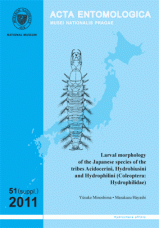Larval morphology of the Japanese species of the tribes Acidocerini, Hydrobiusini and Hydrophilini (Coleoptera: Hydrophilidae)
Minoshima Yusuke, Hayashi Masakazu
Acta Entomologica Musei Nationalis Pragae 51(supplementum): 1-118, 2011
Views: 1138
Abstract: Larval morphology of the Japanese representatives of the tribes Acidocerini,
Hydrobiusini and Hydrophilini (Coleoptera, Hydrophilidae, Hydrophilinae) is
described. Eleven species assigned to seven genera are studied: Agraphydrus
narusei (Satô, 1960) (first and third instars), Enochrus (Holcophilydrus)
simulans (Sharp, 1873) (all instars), E. (H.) umbratus Sharp, 1884 (third
instar), E. (Methydrus) japonicus (Sharp, 1873) (all instars), Helochares
(Helochares) pallens (MacLeay, 1825) (all instars), H. (Hydrobaticus) anchoralis
Sharp, 1890 (first instar), H. (Hydrobaticus) nipponicus Hebauer, 1995 (all
instars), Hydrobius pauper Sharp, 1884 (second and third instars), Hydrochara
affinis (Sharp, 1873) (first and third instars), Hydrophilus (Hydrophilus)
acuminatus Motschulsky, 1854 (all instars), and Sternolophus (Sternolophus)
rufipes (Fabricius, 1792) (all instars). Three aspects of larval morphology were
evaluated for each species studied: (1) general morphology; (2) chaetotaxy of
the head capsule and its appendages; (3) morphological transformations between
instars. Primary chaetotaxy is rather stable among taxa and instars examined,
thus we were able to distinguish primary and secondary sensilla even in the
majority of the second and third instar larvae studied. Secondary chaetotaxy
shows slight intraspecific variation. Presence/absence of secondary sensilla may
be useful at least for distinguishing the first larval instar from later
instars, and often for distinguishing all three larval instars. The arrangement
of primary and secondary sensilla shows differences among the tribes and genera
studied, and between species in Enochrus Thomson, 1859 and Helochares Mulsant,
1844. The pattern of character transformations between larval instars is rather
constant among taxa examined. Generic keys of aquatic Hydrophilidae, tribes
Acidocerini and Hydrophilini from Japan, and key to Japanese species of Enochrus
and Helochares with known larvae are provided.
Key words: Coleoptera, Hydrophilidae, Hydrophilinae, Acidocerini, Hydrobiusini, Hydrophilini, larva, morphology, chaetotaxy, morphological transformation, taxonomy, Japan
